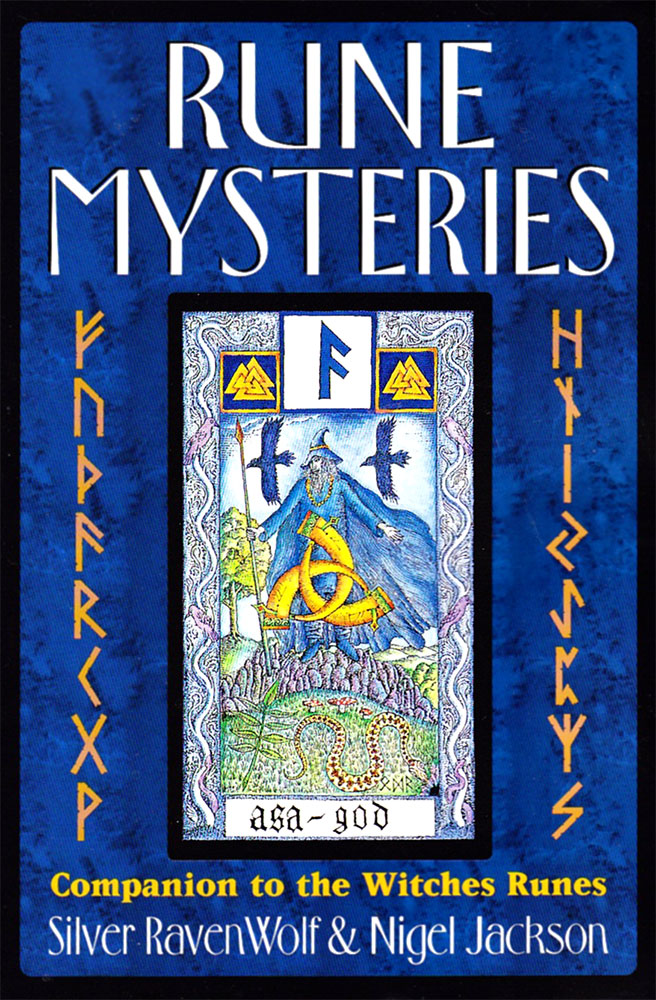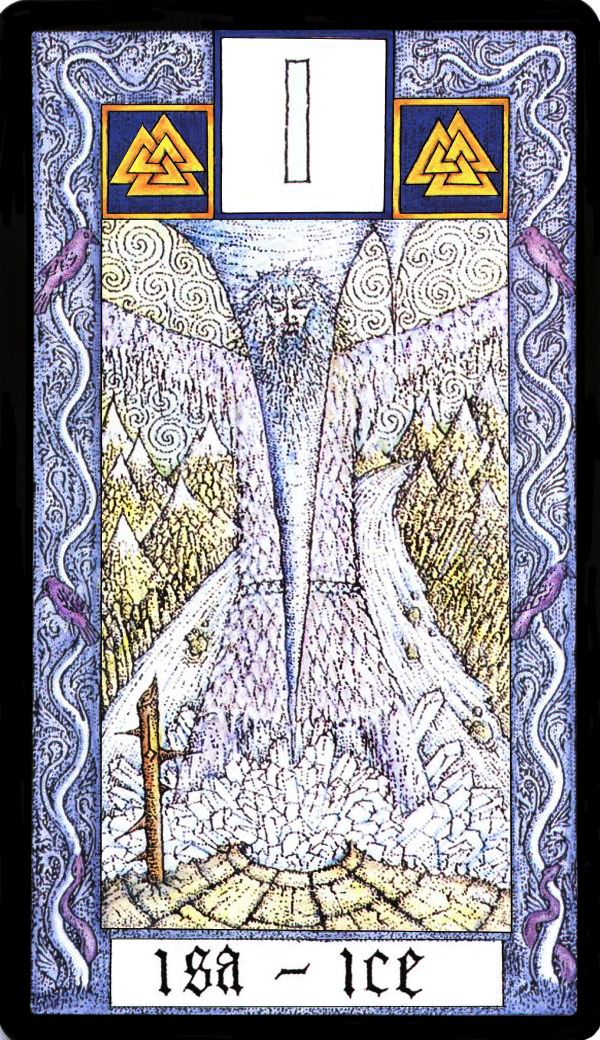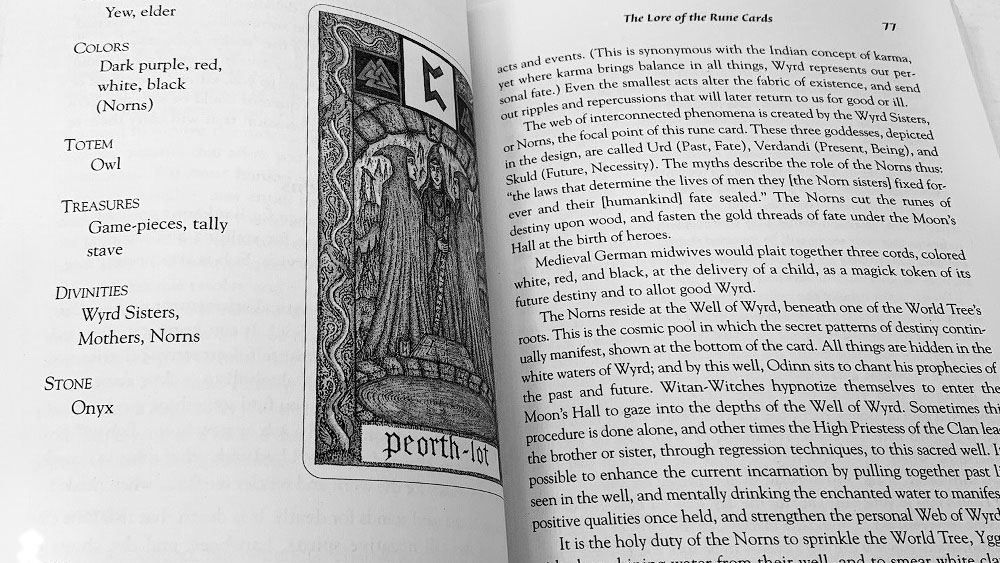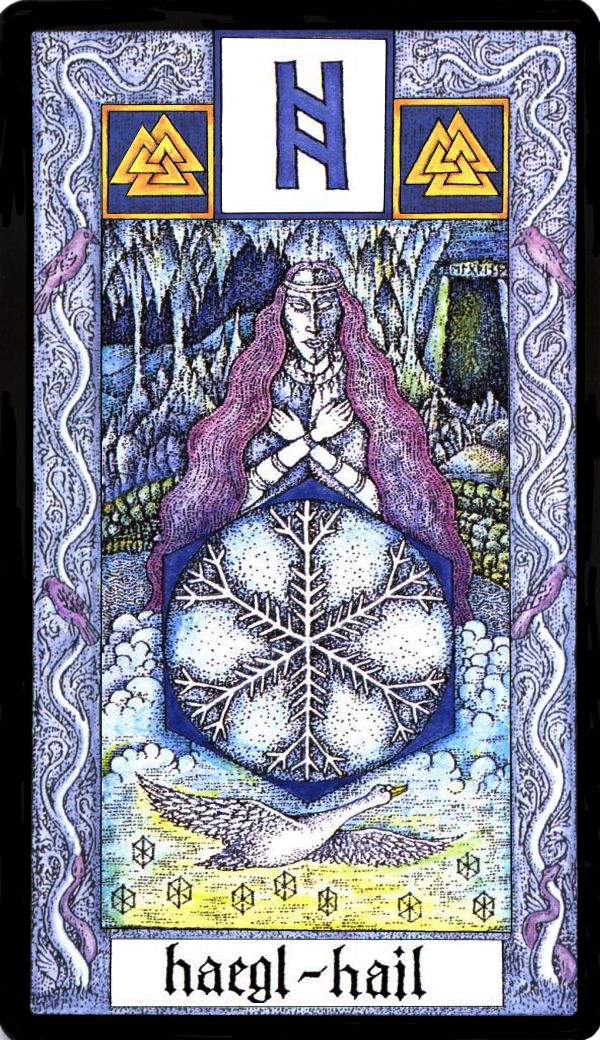 If the ancient maxim “By their inclusion of a blank rune shall ye know them” is true, then any misgivings that arise when encountering a book on the runes by Silver Ravenwolf, of all people, must surely be justified. But that’s not necessarily the case here, and instead what do arise are moments of deep introspection: Am I unfairly judging an author based on their teen Wicca oeuvre because I want to feel cool and occult leet? What does it mean if this book is not irredeemably awful? Am I part of the problem? Let’s find out.
If the ancient maxim “By their inclusion of a blank rune shall ye know them” is true, then any misgivings that arise when encountering a book on the runes by Silver Ravenwolf, of all people, must surely be justified. But that’s not necessarily the case here, and instead what do arise are moments of deep introspection: Am I unfairly judging an author based on their teen Wicca oeuvre because I want to feel cool and occult leet? What does it mean if this book is not irredeemably awful? Am I part of the problem? Let’s find out.
By its very nature, and without even reading the preface, Rune Mysteries feels like a collaboration cooked up at a Llewellyn planning meeting as they looked to churn out another rune product because there hadn’t been one in a while (and we don’t want to have to ask that crotchety old Edred). They then threw together two unlikely and far-flung compatriots: Ravenwolf, who by then was probably a dab hand at writing in Llewellyn’s house style on any subject, and Nigel Jackson, creator of many an oracle set whose artwork is the foundation selling point here.
This book acts as the companion to a set of rune cards sold separately as the Witches Rune. ‘Witch’ is the operative word here, explaining the presence of both Jackson and RavenWolf, figures more associated with witchcraft in its respective traditional English and modern North American strains, rather than the runes. As a result, everything is shot through with a cursory focus that relates the book’s themes back to witchcraft; or at least to an almost entirely theoretical Germanic shamanism that can be cast as an analogue to what is frequently mentioned here, but only later defined, as Witan-Witchcraft.
Without the cards of the Witches Rune themselves, Rune Mysteries works as an approachable, mass-market standalone primer on the runes, providing a layperson’s interpretation of each rune that is not bogged down with, y’know, actual primary sources. Jackson’s designs are reproduced in black and white at a quarter the size of a page for each respective section; but included in colour for this review because, well, aesthetics and impact. As one would expect, things aren’t always entirely rigorous here and droplets of speculation or outright invention can be introduced as if ‘twere fact. The section on the rune Eoh, for example, claims that spiders are sacred to that particular rune, something that would appear to have no precedent elsewhere and even here is not then justified via etymology, analogue or anything. Also, yes, you’re trying to make a metaphysical point about cosmic balance but glibly saying that fire cannot exist without frost (and vice versa) might be, umm, you know, misunderstanding how fire works; or frost for that matter. “One sec, I’m just off to rub some frost together to start a nice fire.” “Oooh, it’s frosty this morning, must have been all that fire we had last night.” Oh, how we laughed.
Putting the mocking of physics-defying metaphysics to one side, there is a general failure within this book to ground the runes within any historical context beyond a casual mention of the entirely theoretical proposition of Bronze Age antecedents. There are zero references to the Elder, Younger or Anglo-Saxon futharks, and so the 24 runes of the Elder Futhark are simply and vaguely referred to as the “ancient Germanic runes.” Such temporally-untethered flowery phrasing is indicative of the language used throughout the book, something that is initiated in an introduction that features a description of a fanciful northern Europe that reads like a black metal checklist: snow-covered peaks, misty heaths, dark woods and storm-wracked seas; a scene lacking only in funeral moons and blazes in the northern sky.
For the record, the names used here for each of the runes are the Anglo-Saxon ones, sans diacritics, though once again, this is somewhat fraught, as the Anglo-Saxon name can be used for an Elder Futhark version of the rune, such as the Anglo-Saxon Cen, which is here rendered graphically as the Elder Futhark version instead of the Anglo-Saxon one. Meanwhile, the fourth rune, which is referred to here as Asa, of course takes the form of the Elder Futhark Ansuz (or the Anglo-Saxon Æsc) rather than the winged form of the Anglo-Saxon futhorc. The lack of references to the various futhark forms predicates that while the description of each rune is broadly based on established interpretations, there are no references to what are, other than etymology, the primary sources for this information: the Norwegian, Old Icelandic and Anglo-Saxon rune poems. This might also explain why some of the rune sections go off on unexpected interpretative tangents, such as Feoh, which begins with a paragraph on standard cattle and wealth symbolism before spending considerably more time on the idea of Feoh as fire, and not just any fire but the primeval fires of Surtr and Múspellsheimr. Needless to say, it’s hard to see quite how you could get to that from the Anglo-Saxon “Wealth is a comfort to all; yet must everyone bestow it freely if they wish to gain honour in the sight of the Lord.”
Not to spend the entire review fact-checking but it is worth mentioning the strange interstitial realm in which this book exists, in which statements are always made categorically and yet little evidence is ever provided, or things are interpreted in a way that would be nice if ‘twere so but are proffered as gospel when the jury is still often out on the matter. Gyfu runes were carved onto heathen “marriage cakes” (no indication of where, when or by whom), crossing one fingers is “actually” an invocation of the same Gyfu rune, and in a lift from Marvel comics, Loki is the brother of Baldr. These wide ranging claims are then often credited, without evidence and context, to comfortably vague sources such as “the Northern folk,” “people of the Northern Way,” and “Indo-European shamanism,” an apparently monolithically unified people mercifully unfettered by the pesky specifics of geography and time.
The general ahistorical wooliness of the content here, and its lack of recourse to primary sources, allows for quite a few howlers to make their way into the copy. There’s the description of Heimdallr guarding a Bifrost bridge that leads not to Midgard but all the way down to Hel, then there’s Fenrir being bound at Ragnarök by Tyr (quite a feat for a newly one-handed god), rather than all the gods, who are in turn credited here with creating the chain that binds the wolf, rather than being made by the dvergar as lore has it. Then there’s the idea that “the Germanic tribes” (presumably all of them, whoever they are) believed that anyone passing under mistletoe was enchanted and blessed by Freyja. The latter is a variation of a bit of perpetually unchecked scuttlebutt and a fanciful retelling of the death of Baldr that has been cut and pasted into a hundred online articles trying to give an ancient lineage to the popular Victorian custom of kissing under the mistletoe. And then there’s dodgy etymology, such as the categorical claim that the name Vanir comes from an Old Norse verb (which unsurprisingly isn’t given) meaning “to be contented, to enjoy.” In reality, the origins of the Vanir name remain inconclusive and the most repeated interpretation suggests that it might derive from the Proto-Germanic *wana-, with a Proto Indo-European root in *wen- (‘to desire, strive for’), a meaning that couldn’t be further from the idyllic, Vanir-as-hippies definition of ‘to be contented, to enjoy.’
Jackson has a history in tarot design, with at least three decks to his credit, and so naturally, Rune Mysteries follows a tarot-like approach in how it presents the runes. After a listing of correspondences (tree, colours, totem, stones, deity), each rune receives an introductory blurb of up to two pages with information of sometimes questionable factual value, loaded with spiritual interpretation, rather than being an etymological or historical exegesis. This is then followed by a section on the rune’s oracular meaning and related keywords, as well as an additional interpretation of the rune when reversed tarot-like. But that’s not all, and each entry concludes with ways in which the reader can work with the respective rune beyond mere divination, providing both weal and woe types of workings, and ending with a brief mention of the various rune-wights and spirit powers that Jackson and RavenWolf have associated, somewhat arbitrarily, with each rune. The latter does feel like they went through a big-list-of-spirits-fairies-and-god-forms™ and just picked out whatever seems vaguely appropriate, such as the Tiwar who are described as “divine Sky-Spirits, humanoid columns of light who descend from the celestial realms robed in luminosity.” As luck would have it “these spirits equate to angels of justice and the armies of the God/dess,” In actuality, and leaving the angelic world and its beings of light behind, dear ones, tívar is just a word used in Old Norse poetry to mean ‘the gods,’ being the indefinite nominative plural form of the singular týr (‘(a) god’) and not all that luminescent, nor incandescent, nor, indeed, angelic.
This factually freewheeling style makes for a fairly thorough system, custom built for the less than discerning and historically-unversed Llewellyn customer, where every rune has a raft of associations, divinatory meanings, correspondences and even entities associated with it, giving the impression of a dense working system. In the latter half of the book there is even more complexity, with a whole practical section that includes page upon page detailing the most propitious days and hours, along with lunar conjunctions, sextiles and trines, for working with each rune. But while all of this feels comprehensive, it’s just not all that authentic, though it is thoroughly in keeping with what one would expect from a Llewellyn title such as this: polished with a marketer’s standards in mind, not those of an academic or pedant.
Beyond the entries for these twenty-four “ancient Germanic runes,” RavenWolf and Jackson provide guidelines for working with the cards, including card care and several tarot-style spreads, with practice draws and reading scenarios. With four spreads, each accompanied by a visual representation, a scenario and an in depth card-by-card reading, this fills a lot of pages and once again is pretty comprehensive and a boon for those that like that sort of thing.
It is this late in the piece that RavenWolf and Jackson define what they mean by a Rune-Witan and Witan-Witchcraft, describing the “Rune-Witan” as a practicing runic magician whose title literally translates as ‘rune-wise-one,’ or ‘one wise in mysteries.’ They claim, without citing chapter and verse, that the term is “quite traditional” since it is found in Beowulf, which somewhat undoes their argument as the witan of Beowulf, sans ‘rune,’ is an Anglo-Saxon council, a plurality rather than a singularity, and linked with governance, rather than esotericism. At a pinch they could have gone with the singular ‘wita,’ but even then, the usage denotes the wisdom and council of politics, not some worker of magic. One could conject that the plural form was chosen because of its similitude with the singular ‘wiccan’ but suffice to say, the etymology here, tracing it back to an unattested Indo-European root of ‘wid,’ is as wild and woolly as some of the other claims about these people of the Northern Way.
RavenWolf and Jackson are on firmer ground in acknowledging the Germanic roots of much of witchcraft’s imagery, aligning the image of the continental witch goddess Holda with Cochrane/Traditional Witchcraft’s idea of a veiled underworld goddess, and positing Woden as her horned equivalent. It is hampered, though, by this persistent need to present such themes as evidence of a continuous and historically unlikely tradition, which inevitably leads to supposition being used to fill in any logical or temporal gaps. We would be remiss if we didn’t mention that this section provides the most appealing aspect of the book, with the chthonic, Helish and witchy imagery striking a resonant note; though feeling thousands of miles away from the historical futhark that forms the book’s basis. This is particularly evident in the Rite of Runa in the final practical section of the book, which sends the practitioner down the Helvegr to “the Hidden land, Hel’s misty apple-wood.” Sure it’s syncretic and a grab bag of influences but the imagery is evocative.
Despite the airing of grievances flowing through this review, Rune Mysteries has something to commend it, perhaps just in its audacity. One wouldn’t want to take a single statement it makes as fact, and one’s salt supply might run dry with a surfeit of pinching, but it’s interesting to see what two people can make from what could have been a mere guide to a set of cards of the “ancient Germanic runes,” with the volume running to over 200 pages and featuring a wealth of practical application. There is an even stronger than usual vibe of everything being made up, particularly in the repeated insistence that this Witan-Witchcraft is an ancient, perpetual tradition, but given that made up stuff is par for the course in occultism, there’s obviously an audience for whom this doesn’t matter. To answer the questions with which this review opened, nope, any misgivings were justified, I’m not part of the problem.
Published by Llewellyn



